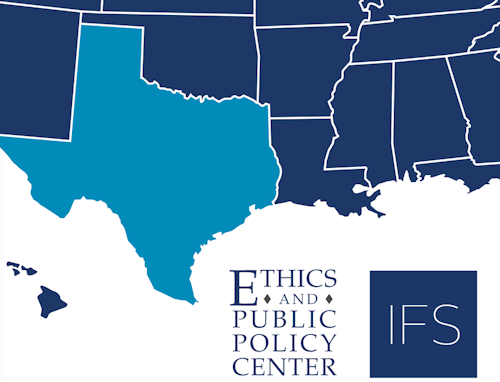
Families Matter to Kids’ Mental Health
One of the major federal population surveys on children’s health issues, the National Survey on Children’s Health (NSCH), provides periodic information on both the health services that young people get, as well as on key characteristics of the different types of families in which they live. What follows is an examination, using these data, of how a child’s family structure relates to his or her need for and receipt of mental health services. (March 2024)

Vindication by the Fifth Circuit Court of Appeals
On March 8, 2024, the U.S. Court of Appeals for the Fifth Circuit upheld a Texas law requiring age verification measures to guard the state’s kids from pornography sites. The decision is a major win for the children of the Lone Star State. It also represents a vindication of the policy work of scholars from the Center for Renewing America, the Ethics and Public Policy Center, and the Institute for Family Studies.

Married People Are Living Their Best Lives
This Institute for Family Studies and Gallup research brief explores the link between marriage and reported well-being among U.S. adults. (February 2024)

A Pro-Family Handbook for Texas
The Institute for Family Studies (IFS) and the Ethics and Public Policy Center (EPPC) recently commissioned a poll from YouGov, asking adults in five growing Sun Belt states about their views on policies that aim to support family life. This report focuses on policies for Texas that are not just politically popular but also can meaningfully advance the goal of making it easier to start and raise a family. (January 2024)

Parenting Is the Key to Adolescent Mental Health
After a decade of surging adolescent mental health problems and suicide, the nation’s leading public health authorities have declared an emergency. Gallup launched a study in the summer of 2023 to understand the causes. We surveyed 6,643 parents, including 2,956 who live with an adolescent, and we surveyed an additional 1,580 of those adolescents. We asked about mental health, visits to doctors, parenting practices, family relationships, activities, personality traits, attitudes toward marriage, and other topics, including excessive social media use. The results are presented here in a joint IFS/Gallup research brief. (November 2023)

Making Smartphones and App Stores Safe for Kids: Federal, State, and Industry Measures
Thi new policy brief from the Institute for Family Studies (IFS) and the Ethics and Public Policy Center (EPPC) presents the current harms to children caused and facilitated by smartphones (and tablets) and the app stores they host, driven by Big Tech companies’ financial incentives that misalign with the welfare of kids. The device-and-app-store industry has been virtually unregulated, especially for child safety. The brief offers several possible solutions for lawmakers and industry leaders to implement, which ensure devices and their app stores are safer for children and bring much-needed accountability. (November 2023)

American Dads Are More Involved Than Ever
American fathers are more involved in their children’s lives than ever. Fathers in America now spend an average of 7.8 hours per week taking care of their children at home, up by 1 hour per week in just about two decades. (Mothers’ child care time remains stable during this period.) However, this rise in fathers’ parenting time does not apply to all dads. This brief by Wendy Wang uses new time diary data from the federal government to show that time with children has increased the most in the past two decades among college-educated, partnered, white, or Asian dads. October 2023

Protecting Kids Online: Legislative Summary
Evaluating the different provisions is important, as these laws are being challenged in court. In light of recent litigation and other states’ desires to pass similar laws, Clare Morell, Adam Candeub, and Michael Toscano have put together a model bill for states to use, drawing on aspects of Utah’s initial legisla- tion and incorporating key edits and provisions—based on the recent injunction against Arkansas’s law—to strengthen it against legal challenges.

Model Legislation for Age Verification of Social Media

How Parenting and Self-Control Mediate the Link Between Social Media Use and Youth Mental Health
This research brief from the Institute for Family Studies and Gallup explores the link between youth mental health and social media use and the effects of parenting and self-control. October 2023

A Pro-Family Handbook for Tennessee
The Institute for Family Studies (IFS) and the Ethics and Public Policy Center (EPPC) recently commissioned a poll from YouGov, asking adults in five growing Sun Belt states about their views on policies that aim to support family life. This report focuses on policies for the Volunteer State that are not just politically popular, but can meaningfully advance the goal of making it easier to start and raise a family. (October 2023)

Do Two Parents Matter More Than Ever?
In this new research brief, Brad Wilcox, Wendy Wang, Spencer James, and Thomas Murray find that college graduation and economic success are more common for young adults from intact families. (September 2023)

The Utah Family Miracle
The strength of the Utah way can be attributed in part to the state’s unique civic, religious, and political endowments, including unusually high levels of social capital and low levels of government regulation. But Utah’s material and emotional success is also attributable to the strength and stability of its families.
The Sutherland Institute and the Institute for Familiy Studies, August 2023

More Scrolling, More Marital Problems
How prevalent is excessive smartphone usage in marriage? Do all marriages suffer from phone addiction equally? What is the link between smartphones and marital quality? Wendy Wang and Michael Toscano take up these and other questions in this IFS research brief. July 2023

Age Verification: Policy Ideas for States
In this policy brief, John Ehrett and Clare Morell offer several different policy ideas on age verification for states considering how best to protect children online. (June 2023)

Protecting Teens From Big Tech: Five Policy Ideas for States
In this legislative brief, Clare Morell, Adam Candeub, Jean Twenge, and Brad Wilcox offer five policy ideas for states to help parents protect their children from the harms of social media. (August 2022)

Strong Families, Better Student Performance: The More Things Change, the More They Remain the Same
In this IFS research brief, Nicholas Zill and Brad Wilcox explore whether family structure matters more for student academic success today than in the past. (August 2022)

No Honey, No Baby: The Relational and Economic Factors Associated With Having Children in America
In this IFS research brief, Wendy Wang uses data from a recent YouGov survey by the Institute for Family Studies and Wheatley Institution to explore the relational and economic factors related to the decline in fertility in the United States. (April 2022)

Exploring Parents’ Perspectives on Paid Leave
This IFS policy brief approaches the question of paid leave through the lens of ascertaining what sort of approach might most appeal to parents and voters. It is informed by interviews with parents who were willing to share individual stories spanning a variety of experiences with both paid and unpaid leave, but also relies on nationally representative polling data to de- velop insights into what approach might be most appealing to voters. (March 2022)

The Religious Marriage Paradox
Is the way religious Americans form their marriages different than the way marriages are formed by their more secular peers? And do religious marriages formed by twenty-somethings face different divorce odds than marriages formed by secular Americans in the same age group? Our new research brief by Lyman Stone and Brad Wilcox addresses these questions. (December 2021)

Happy Liberals Appendix
Appendix with figures and tables for the article, "How Liberals Can Be Happier," by Brad Wilcox, Hal Boyd, and Wendy Wang. (November 2021)

Homeward Bound: The Work-Family Reset in Post-COVID America
Despite all the chaos and struggles over the past year, the fallout from the COVID-19 pandemic gave many parents the first-hand experience of working from home. And they like it. Indeed, the possibilities in workplace flexibility created during the coronavirus crisis may have begun a reset in the way parents think about what they want in their work and family lives—a reset that looks “homeward bound.” More than half of parents with children under age 18 said that COVID-19 has made them more likely to prefer working from home, either most of the time (33%) or half of the time (20%), according to a new Institute for Family Studies/Wheatley Institution survey by YouGov. (August 2021)

Less Poverty, Less Prison, More College: What Two Parents Mean for Black and White Children
From poverty to college graduation to incarceration, black children and young adults from two-parent families are more likely to be flourishing than their white peers from single-parent families, according to a new Institute for Family Studies research brief. (June 2021)

More Than One-Third of Prime-Age Americans Have Never Married
America is the middle of two simultaneous trends related to marriage. Marriages today are more stable, thanks to the steady decline of divorce rates since the 1980s. At the same time, however, a declining share of Americans marry. In 2018, a record 35% of Americans ages 25 to 50, or 39 million, had never been married, according to a new Institute for Family Studies (IFS) analysis of U.S. Census data. The share was only 9% in 1970. (September 2020)

For Getting Kids Through College, Single-Parent Families Are Not All the Same
We tend to think of the various forms of single-parent families—those headed by separated or divorced mothers, never-married mothers, widowed mothers, or by fathers rather than mothers—as all alike, and all equally disadvantaged. And indeed, all these varieties of single-parent families do have lower average incomes than families with two married birth parents. Yet when it comes to putting kids through college, there are significant differences among these family forms. As shown in the following research brief, children who grow up with a divorced or widowed mother are more likely to attend and graduate from a 4-year college than children who grow up with a separated or never-married mother, or with a separated, divorced, or never-married father. (May 2020)

A Child-Focused Paid Parental Leave Policy for the U.S.
A highly contagious coronavirus has led communities to shutter businesses, schools, and public places, requiring families to undertake multiple roles at once: caregivers, educators, and workers. As our society relies on the health and capability of families right now, policymakers should consider future measures that strengthen families, particularly in their childrearing role. (May 2020)

Current Sexual Practices of Evangelical Teens and Young Adults
Evangelicals have historically held a simple view of sex outside of marriage—don’t. Yet social science has shown for years that most self-identified Evangelicals engage in premarital sex. Despite the official teachings of their churches and clear instruction in the Bible, sex outside of marriage has become increasingly morally acceptable among them as well. This IFS research brief by David J. Ayers incorporates the most recent National Survey of Family Growth cycle as of December 2018 to provide an overview of sexual activity among never-married evangelical young people, combining the cycles for 2013-15 with the latest 2015-17 survey. (August 2019)

Less Stable, Less Important: Cohabiting Families’ Comparative Disadvantage Across the Globe
A growing number of children in developed countries today are being raised by parents who are living together but not married. Some argue that cohabiting parents provide a family environment that is comparable to a married household, given that the children are being raised by two adults. However, a new survey of 11 developed countries shows that large shares of cohabiting couples with children under age 18 doubt that their current relationship will last, especially in comparison to married parents. Moreover, cohabiting parents in most countries are less likely than married parents to see their relationship as a vital part of their life. (March 2019)

The Real Housewives of America: Dad’s Income and Mom’s Work
Devotees of reality TV may think that stay-at-home moms are more common among the rich—think the “Real Housewives” of Orange County, of Beverly Hills, of Atlanta, and so on. By contrast, close observers of American family life may think stay-at-home moms are more common among the poor. It turns out they are both right, according to a new Institute for Family Studies analysis of the 2017 American Community Survey by Robert VerBruggen and Wendy Wang. Among mothers married to husbands who work full-time and year-round—the population most likely to have the option of staying home—there is a U-shaped curve between mothers’ chances of being out of the labor force and their husbands’ earned income. That is, the real housewives of America are most likely to be found among women married to men earning just a little or quite a lot. (January 2019)

Meaning in Modern America
American culture is changing in a number of ways that have potentially powerful implications for people’s efforts to find and maintain meaning in life. Americans are waiting longer to get married and have children, and are having fewer children. Feelings of social disconnection and loneliness are on the rise, even as people are increasingly “connected” via social media. Americans are decreasingly religious both in terms of personal faith and involvement in religious organizations (e.g., church attendance. Considering the changing landscape of American culture, I wanted to explore people’s current views on what gives their lives meaning and how these views may be similar and distinct as a function of factors relevant to both social and religious life. (May 2018)

The State of Our Unions: Marriage Up Among Older Americans, Down Among the Younger
The share of married adults in the United States has remained about 50% for more than half a decade, despite a steady drop since the 1960s. But this overall pattern masks the diverging trends by age: Among those ages 18 to 64, the share of currently-married adults has decreased consistently, reaching a record low of 48.6% in 2016, when the most recent Census data was available.1 In contrast, the share among adults ages 65 and older has increased slightly over the past five decades. As a result, adults ages 65 and older became more likely than younger adults to be married in the mid-2000s, and in 2016, a majority of older adults were married. In this new IFS research brief, IFS research director Wendy R. Wang highlights key trends in the share of married and divorced Americans. (February 2018)

Men & Marriage: Debunking the Ball and Chain Myth
Marriage is not worth it for men. It’s not worth the practical and financial sacrifices, the lost romantic opportunities, or the “lack of freedom.” All in all, a spouse is a ball and chain—of little benefit to any man interested in pursuing happiness and well-being. Considering both the latest survey data and the continuing decline in the marriage rate, it’s fair to say that this viewpoint is becoming more entrenched in our society, particularly among younger men. But despite its prevalence, the ball and chain view of marriage is simply not supported by the research. Indeed, the benefits of marriage for men are substantial by every conceivable measure, including more money, a better sex life, and significantly better physical and mental health. Yet many men remain ignorant of these benefits, a view seemingly promoted by popular culture. (February 2017)
Cohabitation, Marriage, and Union Instability in Europe
There has always been a fierce debate about the relationship between cohabitation and divorce risks. Some argue that cohabitation lessens people’s commitment to partnership and thus increases their risk of divorce, while others believe that a cohabitation phase before marriage (as a trial marriage) would strengthen marital stability. (April 2016)
The Paradox of Adoption
Their parents are generally well-educated and affluent. They receive more time and educational resources from those parents than the average child gets from theirs. Yet they get into more conflicts with their classmates at school, display relative little interest and enthusiasm about learning tasks, and register only middling academic performance. About whom are we talking? Adopted children. This is the paradox of adoption in America. (October 2015)
Life Before Marriage: Does What Happens in Vegas Stay in Vegas?
What happens in Vegas stays in Vegas. We tell ourselves this over and over, so it must be true. What if we think about Vegas as what happens in one’s love life before settling down in marriage? Does what happens in that Vegas stay there? Most would say yes—I call this widespread belief the Vegas Syndrome.
Testing a Relationship Is Probably the Worst Reason to Cohabit
“Majority of Americans Now Believe in Cohabitation.” That’s the headline and conclusion from a national survey conducted by the Barna Group. They surveyed 1,097 adults in April 2016, finding that 65 percent ofAmericans now approve of cohabiting prior to tying the knot, while 35 percent do not. Given that nearly 70 percent of Americans marrying today will cohabit before getting married, these findings are not too surprising. The Barna Group also found that 84 percent of those who support premarital cohabitation do so because it provides a test of compatibility prior to marrying. That will be our main focus in this piece .
Counterintuitive Trends in the Link Between Premarital Sex and Marital Stability
American sexual behavior is much different than it used to be. Today, most Americans think premarital sex is okay, and will have three or more sexual partners before marrying. What, if anything, does premarital sex have to do with marital stability? This research brief shows that the relationship between divorce and the number of sexual partners women have prior to marriage is complex.
Sex and Divorce: What’s the Connection?
Are “liberal values the key to saving marriage?” asks economist Noah Smith. He argues, provocatively, that one of the problems with working-class family life is that it is not liberal enough. Working-class men and women are too attached to outdated norms regarding gender, sex, and family life to forge strong and stable families for the twenty-first century, by his account. Jessica Goldstein, Richard Reeves, and Justin Wolfers have made similar arguments about the counterproductive character of cultural conservatism for today’s families. Are they right?
Does the “Marriage of Equals” Exacerbate Educational Inequality?
In a recent article in the New York Times, economist Tyler Cowen contends that the “marriage of equals”—the tendency of women and men to mate and have children with partners who are in the same social class as themselves—helps to propagate inequality across the generations. Noting that assortative mating has increased in recent decades, he argues that, “Of all the causes behind growing income inequality...this development may prove one of the most significant and also one of the hardest to counter.” Cowen focuses on income, wealth, and “power couples,” but assortative mating also occurs in the middle and at the lower end of the socioeconomic spectrum. How much does it contribute to disparities in children’s educational achievement? My analysis of data from a large-scale longitudinal study conducted by the U.S. Department of Education shows just how pronounced assortative mating is among the parents of today’s young adults and how it relates to gaps in the achievement of different groups.
Practice May Not Make Perfect: Relationship Experience and Marital Success
In most areas of life, having more experience is good. Want to be great in your chosen field? Sustained experience is essential. Want to be great at a sport? There’s no substitute for practice. But while more experience is often beneficial in life, the story looks different when it comes to some types of experience before marriage.
How Many Married People Have Thought About Divorce?
Almost everyone wants a happy marriage and wants it to last a lifetime. But most also know the scary U.S. statistics: nearly 50 percent of first marriages and more than 60 percent of second marriages end in divorce. Researchers have discovered a lot about the struggles that lead to marital breakdown and the factors that raise or lower couples’ divorce risk. Strangely, however, we know little about how people consider the option of divorce. What are spouses thinking as they ponder it? How often and how long have they been having these thoughts? What marital problems are they facing, and what do they do to address them?
Want to Avoid Divorce? Wait to Get Married, But Not Too Long
If you hope to avoid divorce, what’s the ideal age to get married? For years, it seemed like the longer you waited to marry, the better. That’s because the relationship between age at marriage and divorce risk was almost linear: The older you were, the lower the chances of divorce. Although teens still face an elevated divorce risk relative to older adults, my analysis of more recent data shows that those who tie the knot after their early thirties are now more likely to divorce than those who marry in their late twenties.
Less Marriage, More Inequality
The standard portrayals of economic life for ordinary American families paint a picture of stagnancy, even decline, amidst rising economic inequality. But rarely does the public conversation about our changing economy, from the pages of the New York Times to the halls of the Brookings Institution, focus on questions of family structure. This is a major oversight: though few realize it, the retreat from marriage plays a central role in the changing economic landscape of American families, in race relations in America, and in the deteriorating fortunes of poor boys. In a word, the increasingly “separate and unequal” character of family life in the United States is fueling economic, racial, and gender inequality.
The Marriage Gap in Europe
It’s common knowledge that fewer people are getting married these days. This has become an increasingly serious problem for the simple reason that most couples who don’t marry don’t stay together, whereas most couples who do marry do stay together. Among parents, roughly eight out of 10 who are married when their child is born will still be together when their child completes secondary education. If the parents don’t marry, the odds of staying together while bringing up a child plummet to three out of 10. That’s a pretty big gap.
Millennial Women and Marriage
Dating and marriage can be a “Tinder” subject these days among Millennials, but let’s be honest, dating is hard and the struggle is real! There was once a time when chivalry existed, men actually initiated relationships, and being pursued by a gentleman was considered an honor for a woman. But today, many Millennial women are trading dating with future intent for instant gratification and pleasure. Young adults think they can pick and chose the perfect mate by viewing a picture of who’s hot and who’s not, all the while leaving character, values, and depth aside. Consequently, we live in an age where many women are trading life-long intimacy through marriage for temporary pleasure, and where the hookup and resulting walk of shame are more likely than a walk down the aisle. But most Millennial women still want to be married, but are choosing to delay marriage. The question is why.
Millennials: Generation Infidelity?
Americans’ disapproval of extramarital sex has dipped in recent years, according to a recent report from Paul Hemez at the National Center for Family and Marriage Research at Bowling Green State University. The first possible cause the researcher brings up are those blasted Millennials might have begun to soil the General Social Survey with their casual attitudes toward sex, including, apparently, sex between a married person and someone who is not his or her spouse. No one hates my generation as much as I do, but I don’t think we deserve the blame for this one.
The Costs and Benefits of Welfare Reform
According to conservatives, by making cash welfare benefits temporary, welfare reform encouraged more poor Americans to enter the labor force, which caused poverty rates to decline. Liberals, for their part, have long held a different view. The earliest critics of welfare reform attributed any drop in poverty to the strong economy of the late 1990s, not the law. More recently, the left has argued that welfare reform increased “extreme poverty” in particular—not poverty in general, not “deep poverty” (half the poverty line), but the state of living with almost no money whatsoever.
Welfare and Marriage in Fishtown
“When you get married, I’m pretty sure that you lose your insurance,” Katie, a 26-year-old cohabiting mother of two who receives Medicaid benefits, said in a recent interview with Institute for Family Studies (IFS) research fellows David and Amber Lapp. The Lapps interviewed a dozen poor and lower-middle-class individuals about how social-welfare programs affect their marriage decisions. Katie is planning on marrying her boyfriend, but she’s also worried about the impact marriage would have on her access to healthcare.
How Family Transitions Affect Students’ Achievement
Among journalists who write about education, the stock explanation for student underachievement and school discipline problems is poverty. Yet there are examples in every school system of students from impoverished family circumstances who do well academically, as well as instances of students from affluent families who get D’s and F’s. When poverty is overemphasized as a cause of instructional ills, other aspects of family life—such as conflict between parents or changes in student living arrangements—are typically ignored or underemphasized. Indeed, it is not generally appreciated how much burden has been placed on our public schools by the revolutionary increases in divorce, cohabitation, and unmarried childbearing that took place over the last half century.
More Than 60% of U.S. Kids Live with Two Biological Parents
Each year the Census Bureau captures a snapshot of the living arrangements of U.S. children through its Current Population Survey. The 2014 results were released by the Bureau last week, and despite all the talk about the growing irrelevance of marriage, 43 million children, a 58-percent majority, were living with both their birth mother and biological father in a traditional married-couple family.
Weak and Strong Links: Asymmetrical Commitment in Unmarried Relationships
With some couples, one partner is substantially more committed than the other. We call these Asymmetrically Committed Relationships (ACRs). No one who is looking for lasting love wants to find themselves in an ACR, but we suspect it has become increasingly easy to land in one. It doesn’t have to be this way.
Marriage is an Important Tool in the Fight Against Poverty
Marriage is no “panacea for poverty,” according to a Center for American Progress (CAP) report by Shawn Fremstad released last week. “Marriage Won’t Cure Poverty,” read the Atlantic headline for an article by Rebecca Rosen spotlighting the CAP report. And, a few years ago, a prominent study by three sociologists framed the question in a way that sounds familiar: “Is Marriage a Panacea?” When progressive policy makers, journalists, and scholars pose the question like this, the answer is never in doubt: marriage is no poverty panacea. But just because putting a ring on it won’t cure poverty, that doesn’t mean the converse is true: namely, marriage plays no role in the fight against poverty. In truth, marriage is one important tool, among others—from high-quality education to wage subsidies for low-income jobs—in the fight against poverty.
The Crime of Nations: The Underappreciated Role of Family Factors
Why do some countries have so much crime? Here in the U.S., we often worry about the fact that our murder rate is so much higher than those of other developed countries. Even more disturbing are crime rates in much of the developing world. Some blame culture; others blame poverty or inequality; still others blame a lack of good government. A new study looks at the question through a different lens: Maybe crime is one manifestation of a “fast life-history strategy”—a bundle of traits, unified by a wide-ranging evolutionary theory, that also includes adolescent fertility and low paternal investment. The results suggest that, indeed, nations with young mothers and absent fathers also tend to have high crime, even after other potential causes have been accounted for.
What Couples with Children Argue About Most
About what are married couples with children most likely to argue? No, it isn’t money, nor being too tired for sex, nor caring for the kids, although all of these are frequent subjects of marital disagreement. The most common area of contention is chores and responsibilities. Nearly half of couples with kindergarten-aged children (49 percent) said they argued about chores and responsibilities “often” or “sometimes.”
Red Families vs. Blue Families: Which Are Happier?
Blue families are stronger and more stable than red families. Until recently, this was the conventional wisdom in the media and the academy. But this belief has been challenged by new reports in Family Studies and the New York Times. At least at the regional level, blue families—that is, families in areas that vote Democratic in presidential elections—do not have an advantage. It turns out that, on average, more conservative counties across the country have more marriage, less nonmarital childbearing, and more family stability for their children.
Race, Ethnicity, and Family Stability in Red and Blue America
Many debates about contemporary family trends involve a clash between two schools of thought, one emphasizing demographic and economic factors and the other emphasizing culture, morality, and religion. The research brief released at Family Studies last week has revealed those fault lines once more. In the brief, we explored how states’ varying levels of family stability relate to their voting patterns in presidential elections.
Extramarital Sex and Religion: Democrats vs. Republicans
Sexual misconduct is also often discussed in the context of religion, perhaps to give journalists something to write between elections. So why not put all three topics forbidden in polite company—sex, politics, and religion—into one blog post? I’ll focus on extramarital sex using a question from the General Social Survey (GSS): “Have you ever had sex with someone other than your husband or wife while you were married?” Obviously, this is only one type of sexual misconduct, and it does not apply to people who have never been married. Still, it’s misconduct that most Americans disapprove of.
Faith and Family, Better Together? Religion and Family Around the Globe
Here in the United States, the increasingly secular caste of American society has gone hand in hand with a retreat from a family-focused way of life that prioritizes marriage and parenthood. As Americans have become less likely to defer to religious authorities—from the Pope to the pastor—and less likely to darken the door of a church on any given Sunday, they have also become less likely to tie the knot and have that third or fourth child.
Religious Service Attendance, Marriage, and Health
Considerable research over the last two decades has been devoted to the relationship between religious participation and health and well-being. Our research indicates that religious service attendance is associated with greater marital stability—or more specifically, with a lower likelihood of divorce. We are not the first to study the relationship between religious service attendance and the likelihood of divorce. In fact, a number of studies have found similar results: namely, that those who attend religious services are about 30 to 50 percent less likely to divorce than those who do not.
Dad and the Diploma
In this policy brief, Brad Wilcox shows that young adults who as teens had involved fathers are significantly more likely to graduate from college, and that young adults from more privileged backgrounds are especially likely to have had an involved father in their lives as teens.
